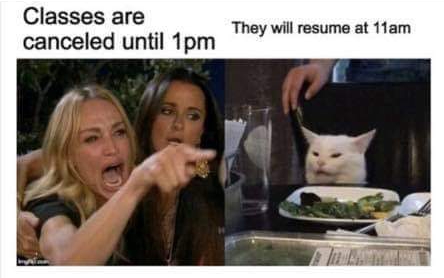I can’t tell you the first time I saw one. At age 11, I had no idea what they were, but I had been living among them for years. They showed themselves in a variety of forms and had slowly begun to take over my world. But it was not until I had started middle school that I learned they had a name… memes. Simply put, memes are any kind of image, video or text content that are usually altered and spread by internet users for comedic purposes. When I first discovered that this was their name, I mistakenly mentioned them to my friends pronouncing it as “mae-mae.” They all laughed at me and quickly corrected my humiliating ignorance. We saw them as inside jokes, showing them to each other in the computer lab during class and cracking up before quickly having to close the browser so the teacher would not see. We didn’t know that these digital images would become an addiction and eventually the entire essence of our generation’s culture.
The term meme was actually coined by evolutionary biologist Richard Dawkins in 1976. For him the term referred to an element of culture or behavior that is passed from one person to another, almost like a gene but by a non-genetic process. However, now the term more commonly refers to deep fried, self-referential images of Elmo staring at a nuclear blast in the distance.

While it can be difficult to pinpoint when memes were first created, some of the first forms can be traced back to the earliest stages of the internet. In the mid-1980’s a form of communication known as 1337 (leet) speak was created. The language swapped out letters for numbers based on the similarity in their glyphs. At the time of their creation digital images did not exist on the internet, so this was really one of the only creative things you could do. It later became more well known in the gamer world where people would use them as gamertags, such as m3m35_4r3_c00l. It was often used to make usernames or post messages that usually were offensive enough to be censored.
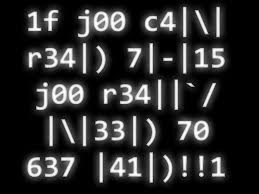
Around 2000, some of the first versions of digital image memes appeared. They usually came in the form of screenshots from video games and online videos with captions. At this point the memes were not really altered at all, they were just repeated for a nice laugh between the people who got the reference. I know it sounds pretty dumb, but I can tell you from experience that my friends and I loved yelling stupid dialogue from the video games we played, like “Do a barrel roll!” from Starfox. And if you don’t believe this kind of meme can have real influence, go ahead and search “do a barrel roll” on Google and see what happens.
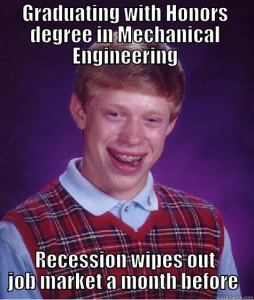
Late aughts meme aesthetics
It was not until the rise of social media like Myspace, Facebook and Youtube in 2005 that people started digitally altering these images and posting them online. However, altering may be a strong word because usually this just meant adding large text over the same image to make it relatable to different scenarios. Later on the standards as to what made a good meme would increase with better access to Photoshop and other editing tools, but in this era people were completely content with extremely undemanding templates. Compared to now, social media was really in an infant stage and the crowd was a lot easier to please when it came to making memes.
While people have always enjoyed creating art, creating memes was not a recognized medium at the time and there was absolutely no financial reward for doing it either. So it seems validation from the niche online community that enjoyed the same content became the main motivator for people to create new memes. This validation lead people to create small online communities where people received recognition for their creative endeavors in a way that they might have never experienced in real life. Introduction of view counts, likes and share buttons incentivised people to create memes hoping they would go viral. Likes and upvotes became a kind of imaginary social currency and memes were the product. Kids started learning how to use software like Photoshop purely so they could get some likes on social media or compliments from peers.
The next chapter in the development of meme culture came from the growth of sites like 4chan and Reddit, which really exploded during 2009 to 2011. These mostly anonymous image and message board/discussion sites provided the perfect format for sharing memes. Memes started to expand from being mainly references to having personal narrative and relatability. 4chan, known for more obscure and darker humor than Reddit, became especially known for its green text stories. These stories started with very believable scenarios and slowly turned completely absurd, which made them easily recyclable for a stream of endless content. Here is one of my favorites:
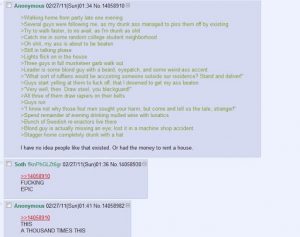
Reddit was created as a much more open online community with a fair amount of content regulation (not to say there aren’t some dark corners). By 2009, rage comics were the hottest product on the market and they were mainly shared on Reddit. They told very short stories that basically exaggerated the struggles of everyday life. I am pretty confident that most people reading this know what I am talking about, but just in case, here is an example:
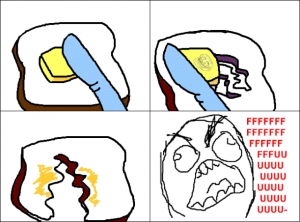
As you can see, the content can be described as almost primitive. Green text stories took a significant level of creative ability but honestly a toddler could probably understand the image above. I think the introduction of rage comics really demonstrates the insertion of memes into mainstream culture. They didn’t immediately take off, but within a couple years of their creation any middle to high school kid knew about these. I think that in some ways this explains why they almost completely died out within a couple years. Indeed, this could be a bookmark in the tale of memes that shows when their shelf life was cut in half. However their demise didn’t occur before they brought very well known characters like Forever Alone Guy and Me Gusta into the public conscious.
I remember my friends sharing them with each other and we thinking we were pretty cool for knowing about a relatively undiscovered meme. Then, seemingly out of nowhere, they were everywhere. Kids even started using them for promoting their student council campaigns. It was the first time I can remember memes crossing over with real life, and it was cringe worthy enough that I wish I could forget. The thing about memes is people kind of treat them like an inside joke that should only be funny to you if it is relatable in some way. So once a meme becomes more mainstream and you see your uncle sharing it on facebook then it kind of loses its magic. So once we saw our precious “me gusta guy” used to promote a campus event, the meme was dead. At that moment we saw it as the end of a meme, but what was brewing was the beginning of a meme revolution.
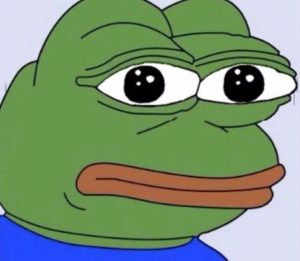 By 2012 we had arrived at the relatively modern era of memes. Obviously there is a lot of content out there but I would say this era started with memes that used a digital image with text overlay. One of the most notorious memes of this generation was Pepe the Frog. Pepe was an anomaly of its own as the character became an iconic figure in internet culture. People would boast over having what they called “rare” Pepe the Frog memes and I even knew people who had albums full of hundreds of variations. This is one meme that outlasted all others. It remained popular for years until it started to become used as a symbol for the online alt-right community. That was a crazy situation all on it’s own.Through a series of unfortunate scenarios and unwholesome variations, the frog turned dark with him dressed as a nazi or in front of a swastika. Now he’s known as a hate symbol and posting pictures of him on Twitter can get your account suspended. Sadly this hijacking means you don’t see Pepe too much anymore.
By 2012 we had arrived at the relatively modern era of memes. Obviously there is a lot of content out there but I would say this era started with memes that used a digital image with text overlay. One of the most notorious memes of this generation was Pepe the Frog. Pepe was an anomaly of its own as the character became an iconic figure in internet culture. People would boast over having what they called “rare” Pepe the Frog memes and I even knew people who had albums full of hundreds of variations. This is one meme that outlasted all others. It remained popular for years until it started to become used as a symbol for the online alt-right community. That was a crazy situation all on it’s own.Through a series of unfortunate scenarios and unwholesome variations, the frog turned dark with him dressed as a nazi or in front of a swastika. Now he’s known as a hate symbol and posting pictures of him on Twitter can get your account suspended. Sadly this hijacking means you don’t see Pepe too much anymore.
Another modern genre of memes is “me irl,” which stands for “me in real life.” The me is the author of the meme (or the person posting it) and the content is self-deprecating, highlighting everyday life scenarios and exaggerated pride in banal accomplishments, or depicting an inability to function in basic social situations. There are deeper and even more meta versions of this type of meme, all of which play into an ironic view of the real world. They are made to be relatable to either a general audience or sometimes more specific interests; however, sometimes they just get ridiculous or work more as an anti-joke.
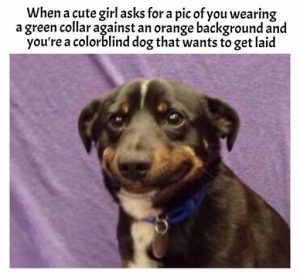
Some memes are just created to mock other memes, especially ones that have become mainstream. That is usually determined by the memes being shared on large social media sites like Facebook or Instagram, where “normies” share their favorite content. (Normies is a term used in the meme community to identify people who get their hands on memes long after their shelf life, and are considered to be more basic in the kind of content they enjoy.) On sites like Reddit, being called a “normie” is an extreme insult and posting normie content on some specific subreddits can get you removed. Obviously there are some who take this more seriously than others. Memes that are made to make fun of these dead memes or normies are called dank memes. They are a whole species of their own, and are really only consumed by avid meme enthusiasts on 4chan and Reddit. I would show you an example but I’m not allowed. I’d prefer to not be banned from one of my favorite subreddits.
Now in the late 2010’s memes have become a kind of art form. People take serious pride in the content they create and share, and even build communities based on them. On Reddit there are subreddits made for specific memes, and posting a meme that doesn’t belong there will get users riled up. One specific example is the separation of Star Wars memes into the Prequel memes subreddit and the Original Trilogy subreddit. Moderators in both communities make sure that memes using content from the wrong trilogy are removed, and there is even a rivalry between the two communities over who has the better content. Sometimes the subreddits even become a meme of their own such as with r/thanosdidnothing wrong. This subreddit was dedicated to posting ironic memes that showed support for the antagonist in Avengers: Infinity War, who wanted to destroy half of the population to bring balance to the universe. In order to honor the character, the subreddit decided to wipe out (ban) half of the users in the subreddit at random, and even the moderators didn’t know who would go. The subreddit actually ended up in a lot of news stories, and on the day of the ban the actual actor who played Thanos got involved and posted a video on the page. It sounds weird, but I can tell you as someone who was literally refreshing the page when the ban happened to see if I was part of the half eliminated, it was pretty cool.
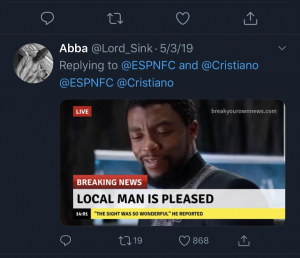 Memes have gotten to an insane level of meta-referentiality, but if you ask most people why they enjoyed memes, they’ll probably just say because they’re funny. And while that may be what gets people started with them, I don’t think the humor behind them is what makes them so addictive. Memes are becoming one of the largest forms of communication in my generation. Everyone has some level of experience with them, and they are used to bring people together based on their interests or just to convey a message without actually writing anything. Just look at any viral tweet and I guarantee that half of the replies don’t even have text, just a picture or gif used to convey their reaction. But there doesn’t need to be any other information shared because most of the people in their twitter community will get the reference and know exactly what the user was trying to say.
Memes have gotten to an insane level of meta-referentiality, but if you ask most people why they enjoyed memes, they’ll probably just say because they’re funny. And while that may be what gets people started with them, I don’t think the humor behind them is what makes them so addictive. Memes are becoming one of the largest forms of communication in my generation. Everyone has some level of experience with them, and they are used to bring people together based on their interests or just to convey a message without actually writing anything. Just look at any viral tweet and I guarantee that half of the replies don’t even have text, just a picture or gif used to convey their reaction. But there doesn’t need to be any other information shared because most of the people in their twitter community will get the reference and know exactly what the user was trying to say.
Twitter has become both a birthplace and landfill for hundreds of viral memes. It seems every week there is a new meme trend that is captioned in different ways to fit unique scenarios or specific groups. One example from this year was a screen grab from “The Eric Andre Show” showing him pleading to get back into an event that he had been kicked out of.

However, my favorite part of this trend is when it reached peak popularity and people decided to flip the meme on its head.

Some have begun to question if this meme camaraderie is a good or bad thing. In some ways it has desensitized people to serious problems in the real world, because there are always memes about them. It reduces life to being one big joke. People make memes about things that actually bother them, like school shootings, the refugee crisis, climate change and just about any controversial topic. One example comes from earlier this year when a tweet was posted about why anyone needs an assault weapon and another user replied with what seemed to be a ridiculous inquiry.
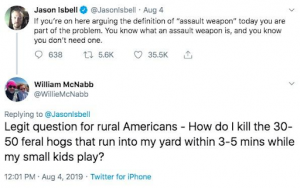
People found this bizarre (but apparently true) invocation of “feral hogs” hilarious and a serious question about the need for gun control after the tragic El Paso shootings turned into a viral meme. 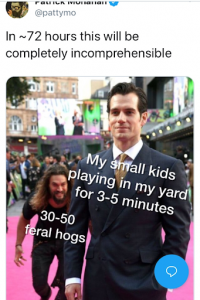 A lot of the time the creators of these memes actually want change, but they’ve concluded that it isn’t going to happen so they just make jokes about it. I see proof for that argument with the interactions I have every single day, whether it be online or in real life. Of course these memes can bring people together, but they can also become extremely exclusive and tone deaf to real life problems. Despite all that, tonight I’ll open up the Reddit app and browse for a while until I see a new funny meme and almost instinctively comment, “Nice meme, dude.”
A lot of the time the creators of these memes actually want change, but they’ve concluded that it isn’t going to happen so they just make jokes about it. I see proof for that argument with the interactions I have every single day, whether it be online or in real life. Of course these memes can bring people together, but they can also become extremely exclusive and tone deaf to real life problems. Despite all that, tonight I’ll open up the Reddit app and browse for a while until I see a new funny meme and almost instinctively comment, “Nice meme, dude.”

